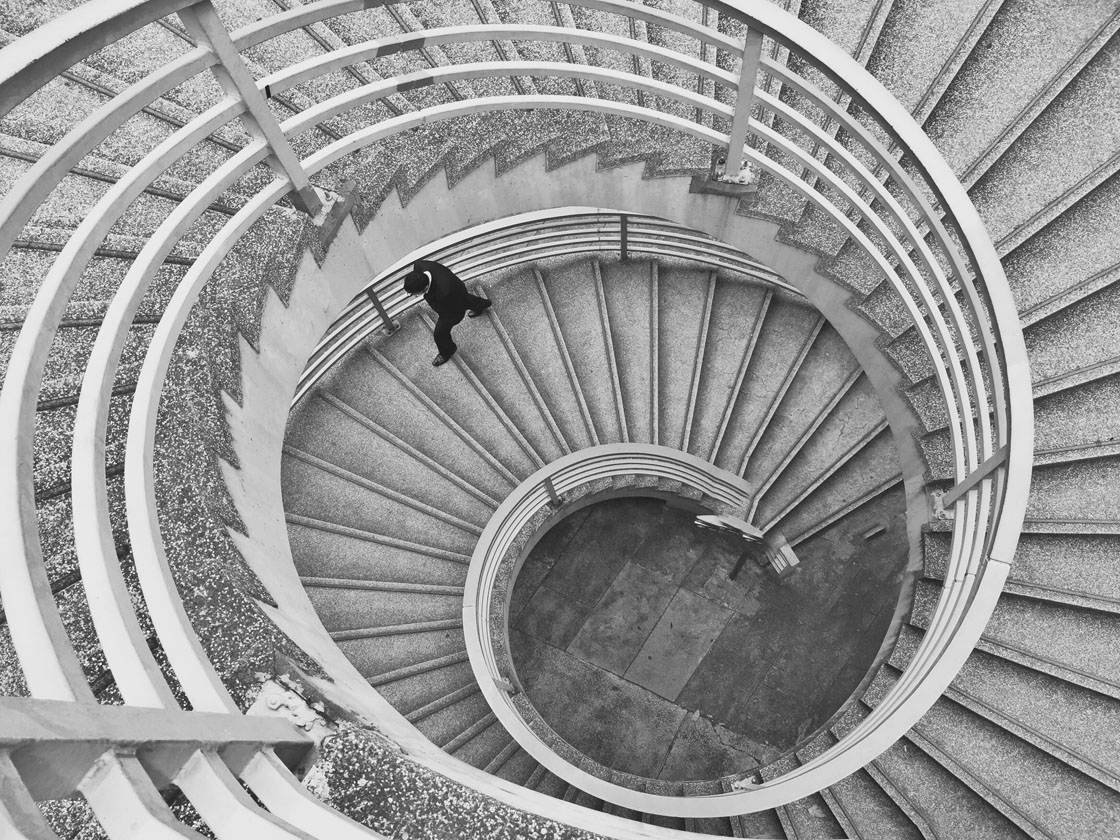Last week we explored ways to improve your iPhone photos of building exteriors. But photographing the interior of a building presents very different challenges in terms of light, subject matter and composition. So what kind of techniques should you use when shooting interior architecture? In this tutorial you’ll discover 10 creative tips for taking stunning iPhone photos of building interiors.

Evelyne Sieber – iPhone Photo Masters Student
1. Photograph Ceilings
When you walk into a building, don’t forget to look up above you. If you only look around at eye level you might be missing out on some great photo opportunities.
Many buildings, especially larger ones, have beautiful and ornate ceilings that will look fantastic in your photos.

Luis Fernandez – iPhone Photo Masters Student
Old buildings such as churches and cathedrals are great places to find stunning detail high up above you.
But modern architecture will also have plenty of interesting ceilings that you can photograph.
Look for shapes and lines above you, and use them to create wonderful abstract compositions like Chris did in the photo below.

Chris Baird – iPhone Photo Masters Student
Don’t forget about smaller buildings too. You don’t have to be in a grand, ornate building to take interesting ceiling photos. Jennifer’s photo below proves this!

Jennifer Fink – iPhone Photo Masters Student
The lines, texture and colors all work together to create a great ceiling photo in this old wooden building.
2. Shoot From High Up
If you have the option of getting up to a high vantage point such as a balcony or the top of a staircase, use this opportunity to shoot down onto the scene below.

Jodie Cooper – iPhone Photo Masters Student
This allows you to capture the building from a completely different perspective, and often creates a more interesting photo than shooting straight ahead at ground level.
If there are people walking around below you, include them in your shot as they’ll add a strong focal point to your image.

Indy Jim – iPhone Photo Masters Student
Another reason to include people in this kind of shot is to add a sense of scale. Their small size compared to the surroundings will emphasize the size of the building.
3. Look For Lines
Lines are one of the fundamental design elements in photography, and they can be used in many different ways.
Buildings are full of lines, so this is the perfect opportunity to practice using them in your compositions.

Evelyne Sieber – iPhone Photo Masters Student
Using leading lines is a classic way to create a strong composition that draws the eye deep into the image. Long hallways in buildings are excellent for creating this kind of shot.
For the most effective composition, aim to have the lines emerging from the bottom corners of the frame, just like Evelyne did in the photo above.

Petra Ipa – iPhone Photo Masters Student
You could also look out for curved lines which create beautiful flow in your images.
Petra’s photo above is a great example of how powerful a spiral can be in a photo.

Evelyne Sieber – iPhone Photo Masters Student
Another way to use lines is to create an abstract quality in your photos. A repeating pattern of lines is an excellent way to achieve this.
4. Explore Corners & Angles
Whenever you’re inside a building, take a few moments to look around for corners and angles.
While this might sound like a strange subject for your photography, they can actually work really well for creating minimal or abstract compositions.

Jeff Betman – iPhone Photo Masters Student
Notice how the lines on the walls and ceiling come together in this corner of the room. The angles created can be used to draw the viewer’s eye into the image to a certain point.
Experiment with your shooting perspective, and the position of the lines and angles, until you achieve a pleasing composition.
5. Photograph Details
We’re often so focused on trying to convey the size and scale of a building, that we forget to focus on the smaller details.
Intricate details allow you to tell a more complete story of the building that you’re exploring. Something as simple as some colorful or ornate tiles will make a wonderful photo when composed in the right way.

Paula Danner – iPhone Photo Masters Student
Paula’s decision to fill the entire frame with these tiles was a great choice. Not only does it create a pattern of squares for an interesting abstract effect, but it also focuses your attention on the amazing blue color.
Choosing to include her feet in the photo adds extra interest and a focal point, but it also tells the viewer that these are floor tiles rather than wall tiles.
Below is another example of focusing on small details in a certain part of the building.

Susan Margulies Kalish – iPhone Photo Masters Student
Look out for interesting details, patterns, textures and ornate objects that will give the viewer a bit more information about the building.
Then work to produce a pleasing composition and use the light to your advantage to create an artistic looking shot.
6. Capture Shadows & Reflections
Wherever you have windows or other openings in a building, you’ll often find shadows and reflections created by the light streaming in.
You can use these shadows and reflections to create photos full of interesting patterns.

When photographing shadows, be sure to adjust the image exposure so that the shadows appear dark enough.
To alter exposure, simply tap the screen to set focus, then swipe up or down to adjust the image brightness.

Linda Krauser McQuaid – iPhone Photo Masters Student
Reflections often appear on shiny surfaces, such a polished floor or the water of the swimming pool below.
Reflections are great for adding pattern and detail to the foreground of an image, as well as creating incredible symmetrical compositions.

Linda Krauser McQuaid – iPhone Photo Masters Student
Be aware that the strength and direction of the sun will change how shadows and reflections appear throughout the day.
So be sure to revisit a building at different times of the day for the best chance of getting a great shot.
7. Photograph Staircases
Unless you’re shooting a single story building, I’d definitely recommend that you seek out some staircases.
Spiral staircases can be used to create the most incredible images. Shooting from the top allows you to use the spiral to gradually lead the eye to the bottom of the building.

Evelyne Sieber – iPhone Photo Masters Student
If possible, include a person on the staircase. This will add a focal point and an extra storytelling element.
You can also photograph spiral staircases from below. This allows you to capture the underneath of the stairs which can be just as interesting.

Lloyd Callaway Jr. – iPhone Photo Masters Student
When photographing spiral staircases, be sure to experiment with your viewpoint and composition. For example, do you want the middle of the spiral to be perfectly central or positioned to one side?
Of course, not all buildings have a spiral staircase, but you can still use a straight staircase to create a great photo.

Chris Baird – iPhone Photo Masters Student
Use the leading lines to draw the eye into the scene and create a sense of depth. Try standing perfectly central to create a powerful symmetrical composition.
8. Shoot Through Windows
Rather than just photographing interior details of a building, how about combining the interior and exterior by shooting through a window or skylight?

Jude Dundas – iPhone Photo Masters Student
Capturing the detail of a window frame adds context to your image. It tells the viewer that you were inside a building at the time of shooting. It also adds great foreground interest and a framing element to the photo.
And the scene outside shows what kind of environment the building is situated in, for example, open countryside, an urban street, an industrial area, etc.

Lloyd Callaway Jr. – iPhone Photo Masters Student
Experiment with the image exposure to create just the effect you want. For example, reducing the exposure will turn the darker foreground into a stunning silhouette that frames the scene outside.
9. Use A Door Or Archway As A Frame
Similar to shooting through a window, taking a photo through an open door or archway allows you to capture both the inside of the building and the scene outside.

Janet Cashin – iPhone Photo Masters Student
The open doorway in the photo above creates a fantastic frame which instantly draws your eye through the door and on to the scene beyond.
10. Include People In Your Shots
There are many great reasons to include people in your architecture photos. They provide a sense of scale, helping the viewer to comprehend how large the building is.

Luis Fernandez – iPhone Photo Masters Student
They also also act as a main subject and point of interest. While the photo above has great symmetry, it wouldn’t have much impact without the person in the scene.
Adding a human element into your architecture shots also helps you tell more compelling stories. It shows how people interact with the architecture around them.

Evelyne Sieber – iPhone Photo Masters Student
Creating a story in your photos is the key to producing interesting and intriguing images that will connect the viewer with the image and hold their attention for longer.
How You Too Can Take iPhone Photos That Everyone Adores
Would you like to start composing incredible iPhone photos of architecture like these? Join our online iPhone Photo Masters course where you’ll receive in-depth tuition from a different world-class iPhone photographer every single month.
Discover insider tips and techniques on a wide range of topics and photography genres, put these skills into practice for the photo assignments, then get feedback and advice from our experts in the monthly photo review sessions.
Plus you’ll get to be part of the incredible iPhone Photography School community where you can interact with other members of the course, as well as our photography experts.
Start improving your iPhone photography today…
CLICK HERE TO JOIN iPHONE PHOTO MASTERS!


Good article, Kate. Lovely work from the students too. I especially appreciated the reminder; “For the most effective composition, aim to have the lines emerging from the bottom corners of the frame” Thank you.
Glad to hear you enjoyed these tips and photos Ardys. That’s a very important point about the lines isn’t it. It’s not enough just to include lines in your photo – you have to position them carefully within the composition for maximum visual impact. I often try out several slightly different angles and perspectives until I’m happy with the result 🙂